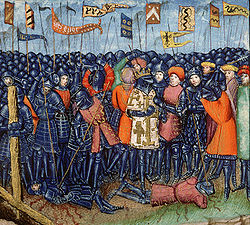Battle of Hattin
| Battle of Hattin | |||||||
|---|---|---|---|---|---|---|---|
| Part of the Wars of the Crusader States | |||||||
 The Battle of Hattin, from a 15th-century manuscript |
|||||||
|
|||||||
| Belligerents | |||||||
|
|
|
||||||
| Commanders and leaders | |||||||
|
|
|
||||||
| Strength | |||||||
|
20,000 men
|
30,000 men
|
||||||
| Casualties and losses | |||||||
| believed heavy | believed light | ||||||
20,000 men
30,000 men
The Battle of Hattin took place on July 4, 1187, between the Crusader Kingdom of Jerusalem and the forces of the Ayyubid sultan Salah ad-Din, known in the West as Saladin. It is also known as the Battle of the Horns of Hattin, from a nearby extinct volcano.
The Muslim armies under Saladin captured or killed the vast majority of the Crusader forces, removing their capability to wage war. As a direct result of the battle, Muslims once again became the eminent military power in the Holy Land, re-conquering Jerusalem and several other Crusader-held cities. These Christian defeats prompted the Third Crusade, which began two years after the Battle of Hattin.
The battle took place near Tiberias in present-day Israel. The battlefield, near the town of Hittin, had as its chief geographic feature a double hill (the "Horns of Hattin") beside a pass through the northern mountains between Tiberias and the road from Acre to the east. The Darb al-Hawarnah road, built by the Romans, served as the main east-west passage between the Jordan fords, the Sea of Galilee and the Mediterranean coast.
Guy of Lusignan became king of Jerusalem in 1186, in right of his wife Sibylla, after the death of Sibylla's son Baldwin V. The Kingdom of Jerusalem was at this time divided between the "court faction" of Guy, Sibylla, and relative newcomers to the kingdom such as Raynald of Châtillon, Gerard of Ridefort and the Knights Templar; and the "nobles’ faction", led by Raymond III of Tripoli, who had been regent for the child-king Baldwin V and had opposed the succession of Guy. Disgusted, Raymond of Tripoli watched as his fellow poulain (permanent settlers descended from the original crusaders) barons hastened to Jerusalem to make obeisance to King Guy and Queen Sibylla. The great lord of Tripoli rode in the opposite direction, up the Jordan River Valley to Tiberias. The situation was so tense that there was almost open warfare between Raymond and Guy, who wanted to besiege Tiberias, a fortress held by Raymond through his wife Eschiva, Princess of Galilee. War was avoided through the mediation of Raymond's supporter Balian of Ibelin.
...
Wikipedia
